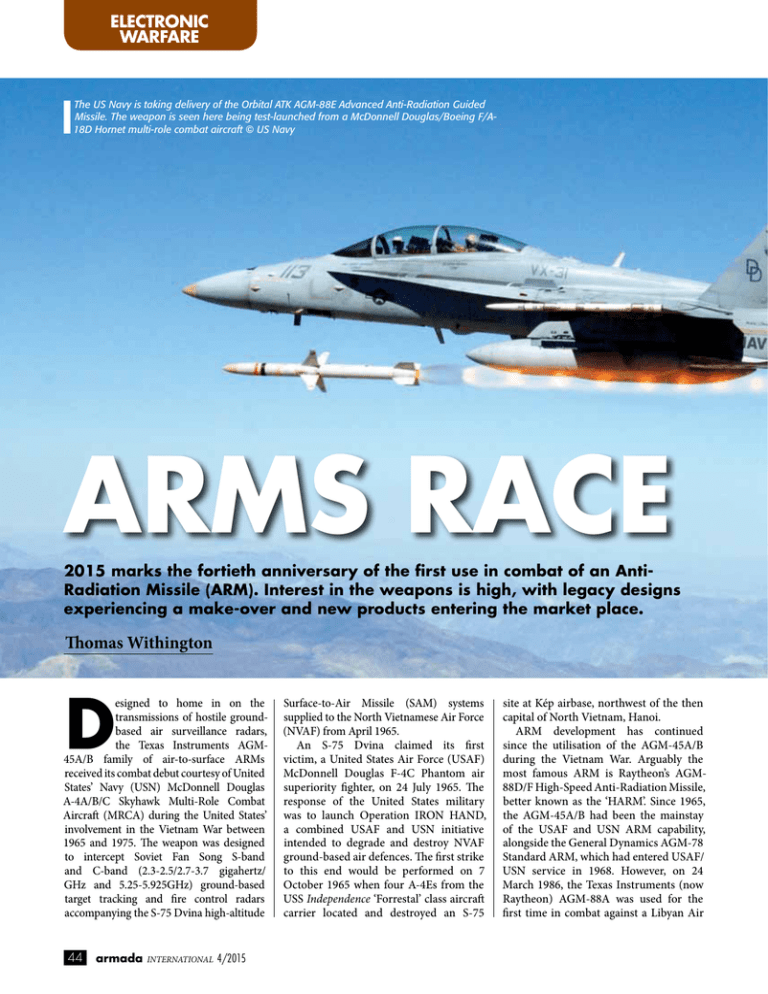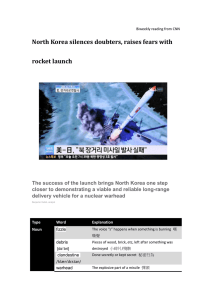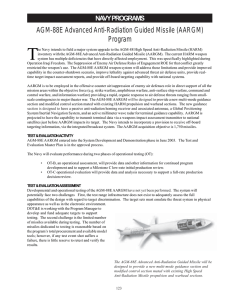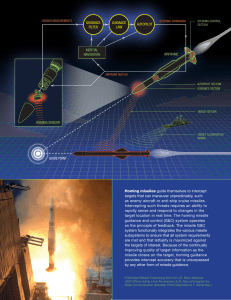ARMs RACE - Armada International
advertisement

ELECTRONIC WARFARE The US Navy is taking delivery of the Orbital ATK AGM-88E Advanced Anti-Radiation Guided Missile. The weapon is seen here being test-launched from a McDonnell Douglas/Boeing F/A18D Hornet multi-role combat aircraft © US Navy ARMs Race 2015 marks the fortieth anniversary of the first use in combat of an AntiRadiation Missile (ARM). Interest in the weapons is high, with legacy designs experiencing a make-over and new products entering the market place. Thomas Withington D esigned to home in on the transmissions of hostile groundbased air surveillance radars, the Texas Instruments AGM45A/B family of air-to-surface ARMs received its combat debut courtesy of United States’ Navy (USN) McDonnell Douglas A-4A/B/C Skyhawk Multi-Role Combat Aircraft (MRCA) during the United States’ involvement in the Vietnam War between 1965 and 1975. The weapon was designed to intercept Soviet Fan Song S-band and C-band (2.3-2.5/2.7-3.7 gigahertz/ GHz and 5.25-5.925GHz) ground-based target tracking and fire control radars accompanying the S-75 Dvina high-altitude 44 armada INTERNATIONAL 4/2015 Surface-to-Air Missile (SAM) systems supplied to the North Vietnamese Air Force (NVAF) from April 1965. An S-75 Dvina claimed its first victim, a United States Air Force (USAF) McDonnell Douglas F-4C Phantom air superiority fighter, on 24 July 1965. The response of the United States military was to launch Operation IRON HAND, a combined USAF and USN initiative intended to degrade and destroy NVAF ground-based air defences. The first strike to this end would be performed on 7 October 1965 when four A-4Es from the USS Independence ‘Forrestal’ class aircraft carrier located and destroyed an S-75 site at Kép airbase, northwest of the then capital of North Vietnam, Hanoi. ARM development has continued since the utilisation of the AGM-45A/B during the Vietnam War. Arguably the most famous ARM is Raytheon’s AGM88D/F High-Speed Anti-Radiation Missile, better known as the ‘HARM’. Since 1965, the AGM-45A/B had been the mainstay of the USAF and USN ARM capability, alongside the General Dynamics AGM-78 Standard ARM, which had entered USAF/ USN service in 1968. However, on 24 March 1986, the Texas Instruments (now Raytheon) AGM-88A was used for the first time in combat against a Libyan Air seeker which could be reprogrammed to to counter the so-called ‘shut down’ home in on new radar threats as and when tactic where a radar operator detecting discovered. The AGM-88B, in production an incoming ARM homing in on their from 1987 improved the missile’s RF transmissions deactivates their radar computer hardware, and included the transmissions so as to cause the missile to AGM-88A Block-II RF seeker. An upgrade lose its target lock. The addition of GPS to the AGM-88B occurred in 1990, re- “enables the weapon to strike targets which designating the weapon as the AGM-88B are not emitting,” says Dewey Holmes, Block-III. From 1993, the AGM-88C Raytheon’s HARM programme manager. became operational which overhauled the Moreover, the missile can be programmed weapon’s explosive charge, adding 12800 with GPS coordinates to indicate areas tungsten alloy fragments to ruin a radar through which it is not permitted to antenna’s day, along with improvements fly, with these GPS coordinates inserted to the weapon’s guidance system and into the missile prior to launch, Mr. ability to attack targets of opportunity; Holmes continues. Setting geographical the latter improvement took the form of parameters for the missile will help to the AGM-88C Block-IV software upgrade. reduce collateral damage. On 28 April Further software improvements adorned 1999, during Operation ALLIED FORCE, the AGM-88C Block-V/AGM-88B Block- the North Atlantic Treaty Organisation’s III (see above) upgrade. (NATO) air campaign to expel Serbian Despite being almost three decades military and Special Police units from the since its first use in combat (see above), Balkans province of Kosovo, an AGM-88 the AGM-88 family shows no signs of of an unknown variant, reportedly hit obsolescence. The latest upgrade of the a house in the suburbs of the Bulgarian missile sees it re-designated as the AGM- capital Sofia, fortunately causing no 88F. This initiative takes existing AGM- injuries. The missile had been targeted 88C Block-IV missiles and adds the ability against a Serbian Air Force and Air to strike targets according to their GPS Defence force ground-based surveillance (Global Positioning System) coordinates radar of an unknown type. via the insertion of the HARM Control Raytheon declined to provide any Section Modification (HCSM) package. details as to whether the RF seeker of the The addition of GPS enables the missile AGM-88F has received any improvements. Force Soviet-supplied 5N62 Square Pair target acquisition and fire control radar accompanying an NPO Almaz S-200 Angara long-range SAM system located on the coast of the Gulf of Sidra, on the southern Mediterranean Sea. The AGM88A was a qualitative improvement on the AGM-45A/B and AGM-78. Whereas the AGM-45A/B and AGM-78 had respective ranges of 22nm (40km) and 49nm (90km), the AGM-88A could reach targets at 80nm (150km) range. Since its combat debut, the AGM88A has been continually redeveloped through several variants. The AGM-88A Block-II added a Radio Frequency (RF) Entering service in the mid-1980s, and used in anger for the first time on 24 March 1986, Raytheon’s AGM-88 family of High-Speed Anti-Radiation Missiles already has several years of combat experience under its belt © US Navy armada INTERNATIONAL 4/2015 45 ELECTRONIC WARFARE While the US Navy is taking delivery of the AGM-88E weapon, the US Air Force is receiving the Raytheon AGM-88F missiles equipped with the HARM Control Section Modification designed to counter the radar ‘shut down’ tactic © USAF Although it would be surprising if it has not. The United States and allied militaries face emerging ground-to-air threats in the form of the Russian Almaz-Antey S-300VM and S-400 Triumf high-altitude SAM system and the China Precision Machinery Import-Export Corporation HQ-9 medium-to-high altitude SAM system, all of which use a myriad of radars yet to be encountered in combat. The AGM-88F upgrade is being performed for the USAF which employs the AGM-88C Block-IV onboard its Lockheed Martin F-16CJ Viper Weasel SEAD (Suppression of Enemy Air Defence) aircraft equipped with the Texas Instruments (now Raytheon) AN/ASQ213A/R7 HARM Targeting System (HTS). The AN/ASQ-213R7 version of the ‘vanilla’ AN/ASQ-213A HTS adds the capability to use ‘dumb’ bombs with weaponsmounted precision guidance equipment such as Boeing’s GBU-31/32/35/38/54 Joint Direct Attack Munition kits. The AN/ASQ-213R7 has a GPS receiver to this end which supply coordinates to these munitions and also, presumably, to the AGM-88F, alongside its traditional 46 armada INTERNATIONAL 4/2015 role of detecting hostile ground-based air surveillance radar transmissions and providing fire control for the ARM. By 2010, all USAF AN/ASQ-213A pods had been upgraded to AN/ASQ-213R7 status. Raytheon received a contract for the Full Rate Production (FRP) of the AGM88F in November 2012 worth $12.3 million, with a second FPR contract worth $14 million awarded in June 2013. Deliveries of these missiles produced under these two FRP contracts commenced in the second quarter of 2014, according to Mr. Holmes, and will conclude by the end of this year. Before the end of 2015, a final AGM-88F flight test is expected to be performed at the USAF Utah Test and Training Range in the western United States. Only the USAF is receiving the AGM-88F, although Mr. Holmes concedes that there has been some interest in the weapon from undisclosed foreign militaries. Additional upgrades may yet occur, particularly to extend the missiles’ range to an undisclosed distance, Mr. Holmes adds, with the USAF planning to maintain the missile in service until around 2035. I AARGM The United States’ other AGM-88 family user is the USN. This service is pursuing its own AGM-88B/C enhancement in form of the AGM-88E Advanced, Anti-Radiation Guided Missile (AARGM). Orbital ATK is leading this initiative. The missile will outfit the Aeronautica Militaire (Italian Air Force) Panavia Tornado-ECR SEAD aircraft (for which the company says the missile will reach Initial Operational Capability in 2016) and in US service, the AGM-88E outfits the McDonnell Douglas/Boeing F/A-18C/D Hornet and Boeing F/A-18E/F Super Hornet Multi-Role Combat Aircraft (MRCA), and Boeing E/A-18G Growler electronic warfare platforms used by the USN and US Marine Corps. Bill Kasting, vice president and general manager of Orbital ATK’s defence electronic systems group, says that the AGM-88E is being certified by the USN at the time of writing (mid-June 2015) for its E/A-18G aircraft. The company notes that the weapon is also designed to equip General Dynamics/ Lockheed Martin F-16 and McDonnell Douglas/Boeing F-15 family Multi-Role Combat Aircraft (MRCA). Anti-Radiation Missiles (ARM) are now a staple of modern air operations since their combat debut during the US involvement in the Vietnam War. This picture shows a radar’s last few moments as it is attacked by an ARM © US DoD The AGM-88E uses the existing motor and airframe of the AGM-88B/C, but adds a new guidance system, plus enhanced control systems. Regarding the guidance system, it contains a millimetre wave radar which is an used to identify and terminally guide on the RF target even if it is shut down. Another counter ‘shut down’ tactic is the addition of a GPS receiver to the weapon, alongside its RF seeker, to enhance accuracy and to neutralise the shut down tactic. Updated target information can be transmitted from the launching aircraft to the AGM-88E via the missiles’ Integrated Broadcast System Receiver. One important aspect of the AGM-88E is that it does not require the employment of the AN/ ASQ-213A/R7 (see above), as the weapon effectively acts as its own targeting pod detecting hostile RF transmissions. The AGM-88E entered Low-Rate Initial Production (LRIP) following the award for a contract to this effect by the US Department of Defence (DoD) in December 2009. Deliveries of all three production lots associated with the LRIP contract were completed in December 2013. Mr. Kasting says that the AGM-88E is in FRP for the USN and Italian Air Force. The firm completed deliveries of the first FRP contract, awarded in September 2012, in May 2016, although a “handful of units” for the Italian Air Force which are included in this production contract will be delivered by the third quarter of this year. Deliveries of missiles included in the second production contract, awarded in September 2013, will be completed by the end of 2016. A third production contract was awarded as of August 2014, with deliveries expected to commence in the first quarter of 2016, and conclude by December 2016, Mr. Kasting continues. He adds that Orbital ATK is currently Superior Mobility under Protection COBRA II APV COBRA URAL TULPAR ARMA 6X6 ARMA 8X8 ELECTRONIC WARFARE off the air by discouraging operators from activating their equipment. Open sources state that the weapon can loiter for several hours in the area of operations, and it has a range of circa 270nm (500km). Harpy is launched from the ground and in Israeli service is used by that country’s air force, plus the armies of the People’s Republic of China (PRC), India, the Republic of Korea and Turkey. According to an IAI source, Harpy has been produced in two distinct variants, the latest of which appeared a decade ago. This latter version has undisclosed improvements in terms of range and performance compared to the original system. The IAI source continued that Harpy has never been tested as an airlaunched weapon, adding that “there is some capability to launch it from an aircraft, but we have not tried it like that because we see no potential to this end.” I MAR-1 Israel Aerospace Industries has taken a different approach with their Harpy anti-radar missile which is ground-launched, and designed to loiter in the target area waiting for a radar to be activated before homing in on the radar’s transmissions © IAI in negotiations with the US DoD for the FRP Lots 4 and 5 for deliveries in 2017 and 2018. Alongside the Italian Air Force and the USN, Mr. Kasting adds that the company is in discussions with the Luftwaffe (German Air Force) regarding the supply of AGM88Es to equip that force’s Tornado-ECR aircraft. However, any purchase “is not expected to materialise for a couple of years”. Nevertheless, on 22 June the US State Department announced approval for the export of 14 AGM-88B (see above) and 16 AGM-88E weapons, along with training rounds and spare parts for $69 million to Australia. Regarding future developments of the AGM-88E, Mr. Kasting adds that “the US Navy has recently implemented funding support in the 2016 President’s Budget request for an Extended Range variant known as AARGM-ER. This development effort is scheduled to commence in 2016 and field improved capability in the 2020 timeframe.” The AARGM-ER is understood to be compatible with the Lockheed Martin F-35A/B/C Lightning-II MRCA internal weapons carriage. the Six Day War of 1965, the Yom Kippur War of 1973 and Operation PEACE FOR GALILEE in Lebanon in 1982. The need to suppress hostile air defences in its hostile locale encouraged Israel Aerospace Industries (IAI) to develop the Harpy loitering munition. Unlike other weapons examined in this article Harpy is a single use Unmanned Aerial Vehicle (UAV) outfitted with a 15 kilogram (32lb) high explosive warhead. Several weapons can be launched to loiter in an area of operations. As soon as one detects a hostile radar, it homes in on the RF emissions, destroying it. Conversely, the ability to deploy several Harpies simultaneously means that they can hold radars at risk simply by loitering in the area of operations, keeping the radars Like Harpy, Mectron’s MAR-1 ARM is shrouded in mystery. Development of the weapon was thought to have commenced in the late-1990s according to publicly available sources. These same sources claim that flight tests commenced in December 2008. The weapon is said to have a range of 54nm (100km) and is capable of detecting and homing on radars transmitting in the 800 megahertz to 20GHz range, allowing it to engage most ground-based early warning, air surveillance and fire control radars. In Força Aérea Brasileira (FAB/ Brazilian Air Force) service, the MAR-1 is believed to be operational onboard the AMX International A-1M ground attack aircraft and the Northrop Grumman F-5EM Tiger-II MRCA. Interestingly, in December 2008, Brazil agreed to provide the Pakistan Air Force (PAF) with 100 MAR-1 missiles for $108 million. These are thought to have been integrated onboard I Harpy Like the United States, Israel is no stranger to air campaigns involving formidable hostile air defences as witnessed during 48 armada INTERNATIONAL 4/2015 Earlier last decade, MBDA examined the possibility of developing an anti-radar variant of its Meteor beyond-visual-range air-to-air missile. However, this has not seemingly progressed to the development stage © MBDA For now, Europe’s anti-radar capabilities rest upon the Tornado-ECR aircraft of the Luftwaffe (German Air Force) pictured here, and their Italian counterparts. These German aircraft may receive the AGM-88E weapon in the future © USAF the PAF’s Dassault Mirage-IIIO ROSE-I (Retrofit of Strike Element-I) MCRAs and Mirage-5F ROSE-II/III MRCAs. In 2011, it was reported that the missile was being integrated onboard the PAF’s Pakistan Aeronautical Complex/Chengdu Aircraft Corporation JF-17 Block-I Thunder MRCAs. Furthermore, it was revealed this April that the MAR-1 will be integrated onboard the 36 Saab JAS-39E/F Gripen MRCA which Brazil signed a contract to acquire in October 2014. I Russian Efforts Russia’s principle ARM is the Tactical Missiles Corporation Kh-31P air-tosurface missile. Entering service in 1988, the weapon is capable of outfitting a range of Russian MRCAs and ground attack aircraft. With a range of 60nm (110km), the weapon destroys radar with a 87kg (192lb) warhead. The missile can be factory-equipped with three distinct RF seekers (L-111, L-112 and L-113) which allow it to engage radars operating across a variety of undisclosed frequency bands. Entering production in 2012, the Kh-31PD has an undisclosed modest range increase, while the Kh-31PM extends the range of the Kh-31PD still further and consolidates the three separate RF seekers of the Kh31P/PD into a single seeker (L-130) which has improved resistance to electronic countermeasures. Trials of the Kh-31PM commenced in circa 2006, although it has not been revealed when this version of the missile entered production. Other Kh-31P variants include the KR-1 exported to the PRC from 1997 which is equipped with a single S-band RF seeker intended to detect the Chungshan Institute of Science and Technology Chang Bai ground-based air surveillance and fire control radar used in conjunction with the Sky Bow-I/II medium-altitude air defence system developed by the same company and in service with the Republic of China Army. The KR-1 missiles exported to the PRC would later form the basis of the Hongdu Aviation Industry’s YJ-91 ARM which entered service with the People’s Liberation Army Air Force in the late-1990s. Compared to the KR-1, this weapon has a longer range of 65nm (120km) compared to the 59nm (110km) of the KR-1. Moreover, it can be equipped with field-changeable rather than factoryinstalled RF seekers. In Russian Air Force service, the Kh31P family of ARMs is reinforced by the Raduga NPO Kh-58 ARM family. Entering service in 1982 with the Soviet Air Force, the Kh-58 has been cycled through several versions. The missile was originally intended to equip the Sukhoi Su-24M ground attack aircraft. The Kh58U version extends the missile’s range from 86nm (160km) for the Kh-58 to 130nm (250km) for the Kh-58U. Export versions include the Kh-58E, which appeared in 1991, and the Kh-58EM which became available in the mid-1990s. Seeker improvements were rolled out onto the Kh-58UShE which equips the missile’s with a single (as opposed to four on legacy versions) RF seeker which, open sources report, could include a frequency spread of one to eleven gigahertz, while the Kh-58UShKE outfitted the Kh58UShE with folding fins to provide semiconformal configuration for the missile when carried by its launching aircraft. The latter version is expected to outfit the Russian Air Force’s forthcoming Sukhoi T-50 fifth-generation MRCA. Production of the Kh-58UShKE is expected to commence this year. I ARM-Less Keen-eyed readers may have noted the lack of discussion regarding European ARMs. The reason for this is simple; there are currently none. The Royal Air Force retired its BAE Systems/MBDA ALARM (Air-Launched Anti-Radiation Missile) in 2013 after it was believed to have been used for a final time during the United Kingdom’s contribution to the NATO’s Operation UNIFIED PROTECTOR combined air and sea campaign in Libya in 2011. For now, Europe’s only ARM capability remains the AGM-88 family (see above) used by the Italian and German air forces. According to sources at MBDA, last decade the company held some internal discussions regarding the possible adaptation of its Meteor beyond visual range air-to-air missile for the antiradar mission. These discussions are not thought to have progressed beyond a small number of presentations detailing this as a possible future mission for the weapon. For now, Europe’s ARM capabilities remain the USN and USAF, and the hope that they will bring their AGM-88 series weapons to suppress hostile air defences during any future air campaign involving the continent and Uncle Sam. armada INTERNATIONAL 4/2015 49


